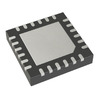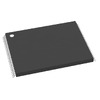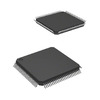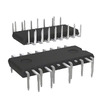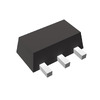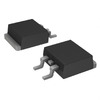Unlocking the ESP12F: Features, Parameters, and Pinout
This article delves into the functionalities and applications of the Ai-Thinker ESP-12F WiFi module, which utilizes the potent ESP8266 processor. Renowned for its compact size and energy efficiency, the ESP-12F is equipped with the Tensilica L106 32-bit microcontroller, supporting speeds of 80 MHz and 160 MHz. The article explores the module's specifications, design, and enhanced features, providing valuable insights and to integrate advanced wireless solutions in various industries.
Catalog
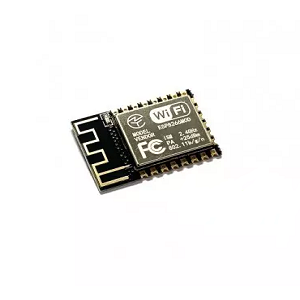
What is the ESP-12F?
Developed by Ai-Thinker Technology, the ESP-12F(ESP8266MOD) module is at the forefront of wireless connectivity's evolution. Anchored by the efficient ESP8266 processor, the module houses a low-power 32-bit microcontroller unit (MCU) within its sleek design. This architecture can attain clock speeds up to 160 MHz, enabling robust real-time operating system (RTOS) performance. Such processing capability empowers the module to tackle intricate tasks with ease, catering to applications that demand prompt responsiveness and adept power management. Furthermore, the ESP-12F integrates full Wi-Fi support, compatible with 802.11 b/g/n standards, and incorporates a comprehensive TCP/IP protocol stack, facilitating seamless network connectivity. Whether functioning as a peripheral interfaced with other devices or as an autonomous controller, its versatility stands out.
ESP-12F Pin Configuration

Features of the ESP-12F
• Integrated MCU and TCP/IP Stack: Built-in 32-bit microcontroller, 10-bit ADC, and full TCP/IP stack for efficient, all-in-one functionality.
• Enhanced RF Connectivity: Includes TR switch, balun, LNA, power amplifier, and matching network for reliable wireless communication.
• Flexible Networking and Security: Supports multiple antenna types, WPA/WPA2 security, and operates in Station (STA), Access Point (AP), and STA+AP modes.
• Power Efficiency: SDIO 2.0 for fast data transmission and deep sleep mode for low power consumption in battery-based applications.
• Strong Signal and Extended Range: High output power in 802.11b mode for better signal strength and wider coverage.
• Regulatory Compliance: Certified for FCC, CE, and RoHS standards, ensuring quality and compatibility.
• Versatile Use Cases: Ideal for IoT, smart devices, and industrial applications due to its adaptability and high performance.
Schematic Diagram of the ESP-12F
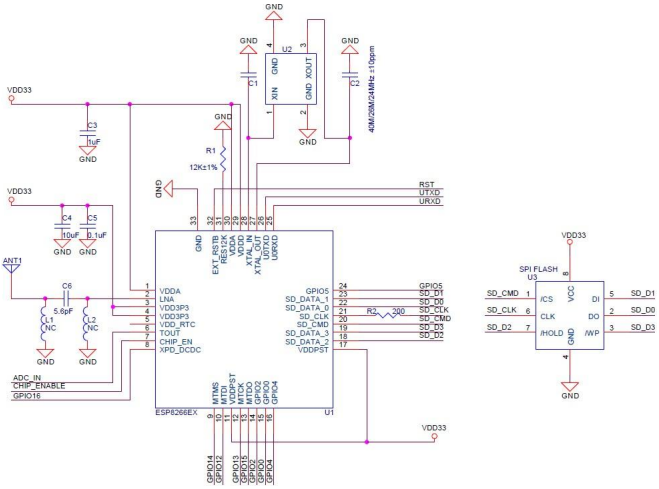
ESP-12F Parameters
|
Categories |
Items |
Values |
|
WiFi Parameters |
Certificates |
FCC/CE/ROSH |
|
Protocols |
802.11 b/g/n |
|
|
Frequency Range |
2.4GHz-2.5GHz (2400M-2483.5M) |
|
|
Hardware Parameters |
Peripheral Bus |
UART, SPI, I2C, I2S, IR Remote Control |
|
GPIO/PWM |
Available |
|
|
Operating Voltage |
3.0~3.6V |
|
|
Operating Current |
Average value: 80mA |
|
|
Operating Temperature Range |
-40°~125° |
|
|
Ambient Temperature Range |
Normal temperature |
|
|
Package Size |
N/A |
|
|
External Interface |
N/A |
|
|
Software Parameters |
Wi-Fi Mode |
station/softAP/SoftAP+station |
|
Security |
WPA/WPA2 |
|
|
Encryption |
WEP/TKIP/AES |
|
|
Firmware Upgrade |
UART Download / OTA (via network) / Host firmware upload |
|
|
Software Development |
Supports Cloud Server Development / SDK for custom
firmware development |
|
|
Network Protocols |
IPv4, TCP/UDP/HTTP/FTP |
|
|
User Configuration |
AT Instruction Set, Cloud Server, Android/iOS App |
Block Diagram of the ESP-12F
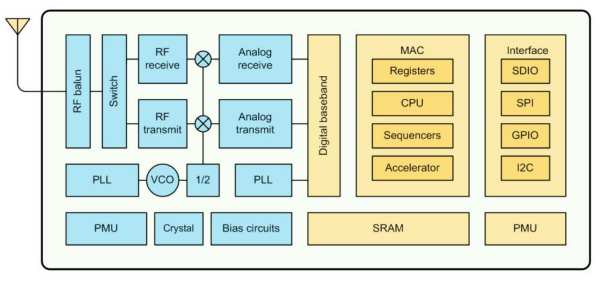
Absolute Maximum Ratings for ESP-12F
|
Rating Condition |
Value |
Unit |
|
Storage Temperature |
-40 to 125 |
°C |
|
Maximum Soldering Temperature |
260 |
°C |
|
Supply Voltage |
+3.0 to +3.6 |
V |
ESP-12F Specifications
|
Type |
Parameter |
|
Package / Case |
WiFi Module |
|
Packaging |
Tape & Reel (TR) |
|
RoHS Status |
RoHS Compliant |
About us
ALLELCO LIMITED
Read more
Quick inquiry
Please send an inquiry, we will respond immediately.
Frequently Asked Questions [FAQ]
1. How do I integrate an ESP8266 ESP-12F with an Arduino Mega?
Integrating the ESP8266 ESP-12F with an Arduino Mega involves several steps to achieve a flawless connection through the UART interface. Begin with a 3.3V power supply for the ESP8266 to prevent damage from higher voltages. Due to the ESP8266's power needs, using a dedicated power source can help stabilize the operation and reduce power-related issues. To bridge the difference between the ESP8266’s 3.3V and the Mega’s 5V logic levels on the TX/RX pins, utilize a voltage level shifter for safe and effective communication. AT commands are invaluable in setting up the module, considerably increasing its functionality for more intricate tasks. For debugging and issuing commands, SoftwareSerial can be used to simulate extra serial ports, enhancing flexibility and control throughout development.
2. What features does the ESP8266 offer?
The ESP8266 stands out as a compact, efficient System on a Chip (SoC) designed for wireless communication, specifically apt for environments where space and energy optimization are needed. By embedding Wi-Fi capabilities, the ESP8266 supports both embedded systems and standalone modes, providing an economical solution with minimal spatial requirements. Its reliability and performance are proven across various mobile platforms, illustrating the SoC's adeptness at merging functionality with constraints. This ability to satisfy device specifications shows its role in promoting widespread technological integration.

LM555 Timer: Pinout, Features, and Datasheet
on November 13th
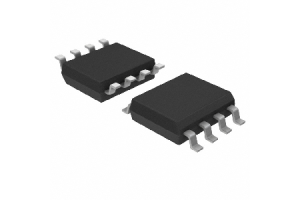
LM318: Circuit, Pinout, and Alternatives
on November 13th
Popular Posts
-

What is GND in the circuit?
on January 1th 3177
-

RJ-45 Connector Guide: RJ-45 Connector Color Codes, Wiring Schemes, R-J45 Applications, RJ-45 Datasheets
on January 1th 2755
-

Understanding Power Supply Voltages in Electronics VCC, VDD, VEE, VSS, and GND
on November 18th 2430
-

Fiber Connector Types: SC Vs LC And LC Vs MTP
on January 1th 2219
-

Comparison Between DB9 and RS232
on January 1th 1840
-

What Is An LR44 Battery?
Electricity, that ubiquitous force, quietly permeates every aspect of our daily lives, from trivial gadgets to life-threatening medical equipment, it plays a silent role. However, truly grasping this energy, especially how to store and efficiently output it, is no easy task. It is against this background that this article will focus on a type of coin cell battery that may seem insignificant on the...on January 1th 1810
-

Understanding the Fundamentals:Inductance Resistance, andCapacitance
In the intricate dance of electrical engineering, a trio of fundamental elements takes center stage: inductance, resistance, and capacitance. Each bears unique traits that dictate the dynamic rhythms of electronic circuits. Here, we embark on a journey to decipher the complexities of these components, to uncover their distinct roles and practical uses within the vast electrical orchestra. Inductan...on January 1th 1765
-

CR2430 Battery Comprehensive Guide: Specifications, Applications and Comparison to CR2032 Batteries
What is CR2430 battery ?Benefits of CR2430 BatteriesNormCR2430 Battery ApplicationsCR2430 EquivalentCR2430 VS CR2032Battery CR2430 SizeWhat to look for when buying the CR2430 and equivalentsData Sheet PDFFrequently Asked Questions Batteries are the heart of small electronic devices. Among the many types available, coin cells play a crucial role, commonly found in calculators, remote controls, and ...on January 1th 1737
-

What Is RF and Why Do We Use It?
Radio Frequency (RF) technology is a key part of modern wireless communication, enabling data transmission over long distances without physical connections. This article delves into the basics of RF, explaining how electromagnetic radiation (EMR) makes RF communication possible. We will explore the principles of EMR, the creation and control of RF signals, and their wide-ranging uses. The article ...on January 1th 1725
-

Comprehensive guide to hFE in transistors
Transistors are crucial components in modern electronic devices, enabling signal amplification and control. This article delves into the knowledge surrounding hFE, including how to select a transistor's hFE value, how to find hFE, and the gain of different types of transistors. Through our exploration of hFE, we gain a deeper understanding of how transistors work and their role in electronic circu...on November 18th 1715








